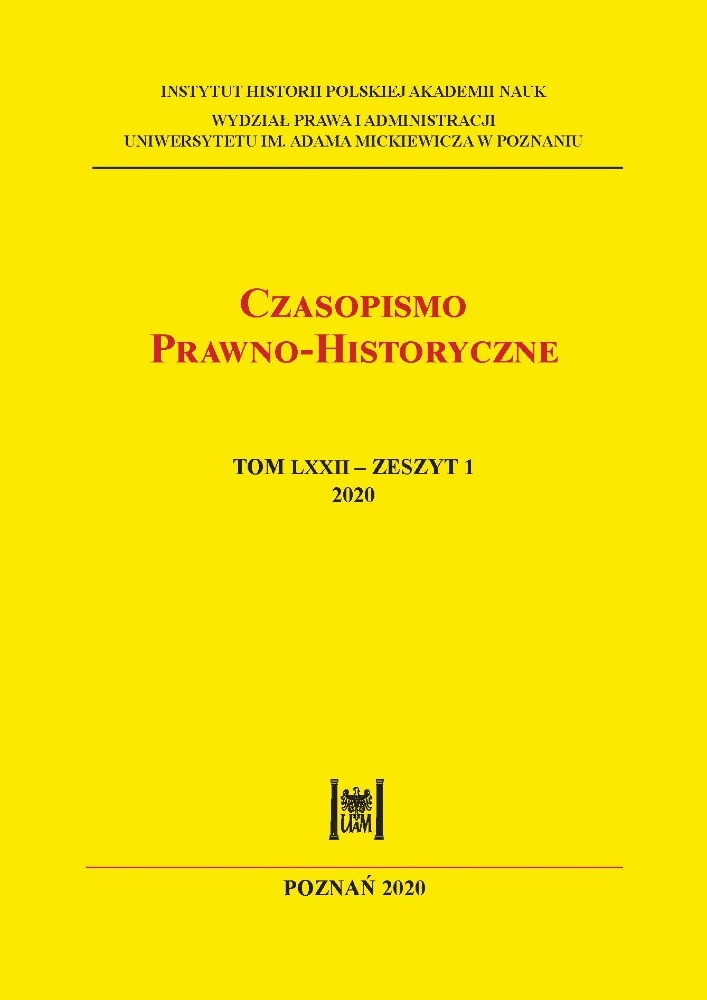Abstrakt
Chociaż Dariusz i (522–486 p.n.e.) z dynastii Achemenidów nie wprowadził uniwersalnego prawa królewskiego w Persji, w swoich inskrypcjach używał staroperskiego terminu dāta-, „prawo”. W kontekście lokalnym, w Persepolis i Fārs, termin ten miał dwa znaczenia: 1) ideologiczne, gdyż był związany z obowiązkami poddanych i państw imperium wobec króla oraz 2) gospodarcze, gdyż był używany w przepisach o wymianie surowców w gospodarce Persepolis. W inskrypcjach królewskich termin dāta- reprezentuje lojalność podbitych krajów i hołd, jaki są winni królowi. Prawo to zapewniało stabilność krajom poddanym. Sam termin jest powiązany z koncepcją prawdy i kłamstwa w królewskich inskrypcjach i tożsamy z terminem ṛštā-, „prawość”. Zgodnie z ideologią Achemenidów lojalne kraje i ludzie byli wyznawcami prawdy i prawości, kiedy zaś stawali się nielojalni, byli wyznawcami kłamstwa. Dariusz w swoich inskrypcjach podkreśla, że nie był nielojalny, nie kierował się kłamstwem, ale prawością. Dlatego zarówno on, jak i inni królowie Achemenidów podlegali tym samym prawom. W Archiwum Fortyfikacji Persepolis, zbiorze dokumentów administracyjnych z czasów panowania Dariusza I, znajduje się elamicki termin datam (interpretacja staroperskiego dāta-). Występuje tylko w kilku tekstach związanych z wymianą towarów na šaumarraš, czyli sztabki srebra. Wymiana ta odbyła się „zgodnie z poprzednimi przepisami (datam)” (alternatywnie „wcześniejszymi dekretami”). Sugeruje to, że w Persepolis kurs walutowy, podobnie jak reszta gospodarki, był kontrolowany przez państwo. Takie użycie terminu dāta- jest zatem znacznie bliższe współczesnemu rozumieniu terminu „prawo”.
Bibliografia
Bartholomae C, Altiranisches Wörterbuch, Strassburg 1904.
Briant P., From Cyrus to Alexander: A History of the Persian Empire, Winona Lake 2002.
Briant P., Henkelman W.F.M., Stolper M.W. (red.), L’archive des fortifications de Persépolis: état des questions et perspectives de recherches, Persika, Paris 2008.
Brosius M., Reconstructing an Archive: Account and Journal Texts from Persepolis [w:] M. Brosius (red.), Ancient Archives and Archival Traditions: Concepts of Record-Keeping in the Ancient World, Oxford 2003.
Roth M.T. (red.), The Assyrian Dictionary of the Oriental Institute of the University of Chicago (CAD), vol. 15 S, 1984.
Fisher M.T., Stolper M.W., Achaemenid Elamite Administrative Tablets, 3: Fragments from Old Kandahar, Afghanistan, „Arta” 2015, nr 001.
Hallock R.T., Persepolis Fortification Tablets, Oriental Institute Publications, Chicago 1969.
Henkelman W.F.M., Imperial Signature and Imperial Paradigm. Achaemenid Administrative Structure and System across and beyond the Iranian Plateau [w:] B. Jacobs, W.F.M. Henkelman, M.W. Stolper (red.), Die Verwaltung im Achämenidenreich: Imperiale Muster und Strukturen. Administration in the Achaemenid Empire: Tracing the Imperial Signature, Wiesbaden 2017.
Herrenschmidt C., Aspects universalistes de la religion et de l'idéologie de Darius Ier [w:] G. Gnoli, L. Lanciotti (red.), Orientalia Iosephi Tucci memoriae dicata, Roma 1987.
Kawase T., Sheep and goats in the Persepolis Royal Economy, „Acta Sumerologica” 1980, nr 2.
Lincoln B., Religion, empire, and torture. The case of Achaemenian Persia, with a postscript on Abu Ghraib, Chicago 2007.
Oktor Skjærvø P., Avestan Quotations in Old Persian? Literary Sources of the Old Persian Inscriptions [w:] Sh. Shaked, A. Netzer, Irano-Judaica IV: Studies Relating to Jewish Contacts with Persian Culture throughout the Ages, Jerusalem 1999.
Olmstead A.T., History of the Persian Empire, Chicago 1959.
Persepolis Fortification Archive Project w środowisku OCHRE, ochre.uchicago.edu.
Schmitt R., Die altpersischen Inschriften der Achaimeniden, Wiesbaden 2009.
Schmitt R., The Bisitun inscriptions of Darius the Great: Old Persian Text, Corpus Inscriptionum Iranicarum, cz. I: Inscriptions of Ancient Iran, London 1991.
Schmitt R., The Old Persian inscriptions of Naqsh-i Rustam and Persepolis, Corpus Inscriptionum Iranicarum, cz. I: Inscriptions of Ancient Iran, London 2000.
Schmitt R., Wörterbuch der altpersischen Königsinschriften, Wiesbaden 2014.
Stolper M.W., Investigating Irregularities at Persepolis [w:] B. Jacobs, W.F.M. Henkelman, M.W. Stolper (red.), Die Verwaltung im Achämenidenreich: Imperiale Muster und Strukturen. Administration in the Achaemenid Empire: Tracing the Imperial Signature, Wiesbaden 2017.
Tamerus M., Elusive Silver in the Achaemenid Heartland: Thoughts on the Presence and Use of Silver According to the Persepolis Fortification and Treasure Archives [w:] K. Kleber, R. Pirngruber (red.), Silver, Money and Credit: A Tribute to Robartus J. van der Spek on the Occasion of his 65th Birthday, Leiden 2016.
Voigtlander E.N. von, The Bisitun Inscription of Darius the Great: Babylonian Version, Corpus Inscriptionum Iranicarum, cz. I: Inscriptions of Ancient Iran, London 1978.
Licencja

Utwór dostępny jest na licencji Creative Commons Uznanie autorstwa – Użycie niekomercyjne – Bez utworów zależnych 4.0 Międzynarodowe.





